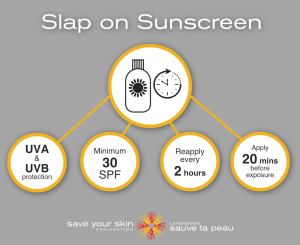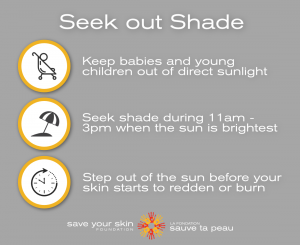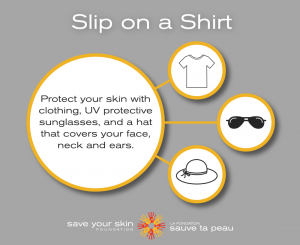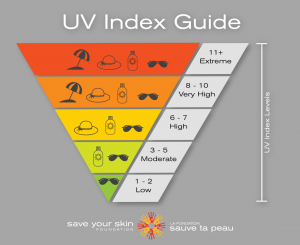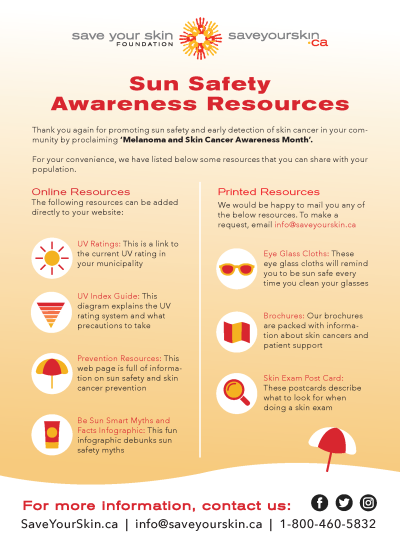AVOIDING SKIN DAMAGE FROM UV RAYS IS THE MOST IMPORTANT THING WE CAN DO.
The damage that leads to adult skin cancers starts in childhood and teenage years, as people are likely to receive about 80% of their lifetime sun exposure during the first 18 years of life.
No tan is a safe tan.
No cancer, including melanoma, can ever be prevented with 100% certainty. The good news with melanoma is that the risk factors are well known, so steps can be taken to dramatically reduce your risk of developing this deadly disease.
- Always have sunscreen with you so you can apply it whenever an unplanned outdoor activity arises
- Use a sunscreen with an SPF of at least 30 whenever you are outdoors (even on grayer days)
- Wear protective clothing with long sleeves, hats, and sunglasses
- Wear sun safety apparel for added protection
- Check for changes in moles, new moles and see your doctor immediately if anything is suspicious
- Limit sun exposure between 10 am and 4 pm
- Do not use tanning beds
For outdoor labour occurring on sunny days, especially between 10 a.m. to 4 p.m., workers are encouraged to:
- Work in shaded areas when able
- Wear full-body coverage clothing, including: full-brimmed hats, long-sleeve shirts and full-length pants made of tightly woven fabric that is lightweight
- Wear sun safety apparel for added protection
- Wear full-spectrum sunglasses that protect from UVA and UVB rays
- Apply SPF of 30+ at least twenty minutes before going outside
- Use lip balm that has a SPF of at least 15
Sun protection training and materials should be provided to staff, encouraging them to practice sun safety both on the job and engaging in outdoor pastimes.
These guidelines should be communicated and reinforced to employees through verbal reminders, posters, signs, pamphlets, notice, payroll stuffers, newsletters, and meetings.
What does a sunscreen’s “SPF” rating mean?
All sunscreens have a sun protection factor (SPF) on their labels. SPF is a measure of the amount of UV radiation that can reach the skin with sunscreen compared with no sunscreen. For example: SPF 15 filters out approximately 93 percent of all incoming UVB rays. SPF 30 keeps out 97 percent and SPF 50 keeps out 98 percent. No sunscreen can block all UV rays.
Broad spectrum sunscreen provides protection from both UVB and UVA rays. In Canada, regulations depict sunscreen labeling for broad spectrum; look for labels that use the words “Broad Spectrum” and show an image of UVA with a circle around it +UVB.
Overexposure to ultraviolet radiation can cause sunburns. Mild sunburns can be treated, however severe sunburns require medical attention.
Here is some advice for treating a mild sunburn:
- Avoid creams or lotions that may hold heat inside the skin or may contain numbing medication (i.e. Benzocaine or lidocaine)
- Use of Aloe Vera
- Do not wash burned skin with harsh soap
- For pain relief, you may use ibuprofen or acetaminophen, as directed
- Do not give aspirin to children
- Cover all sunburned areas
In the case of a severe sunburn, seek medical attention. Symptoms include:
- Sunburn that forms blisters or is extremely painful
- Facial swelling
- Nausea, fever or severe chills
- Pale or cool skin
- Rapid pulse or rapid breathing
- Headache, confusion or a feeling of faintness or dizziness
- Signs of dehydration (increased thirst, dry eyes and mouth, no urine output)
- Signs of skin infection (increasing redness, warmth, pain, swelling, or pus)
- Eyes that hurt and are sensitive to light
Tanning beds and sun lamps release UV rays that can cause sunburns, damage skin and increase the risk of skin cancer.
People at tanning salons may tell you their lights are safe, but the fact is their lights may give from 10 to 15 times as much UVA as the sun.
Many studies have demonstrated that the risk of developing cutaneous melanoma can increase up to 75% when tanning devices are used before the age of 35.
While sunlight has health benefits, it is important to take precautions to protect ourselves from potentially harmful UV rays.
During the Winter and Spring months, it is important to protect yourself while pursuing snow sports, such as skiing, snowboarding, or snowshoeing. The sun’s reflection off of snow can increase the amount of UV radiation you receive by up to 85%. Wearing sunscreen and sunglasses will help protect exposed areas. It is recommended that you take the same precautions during Summer water sports.
An SPF30 is the minimum protection recommended, and sunscreen should be applied twenty minutes before heading outdoors to allow for activation time. Remember to reapply every two hours, or after swimming or perspiring.
When you are unsure of the UV strength on a particular day, it is useful to consult the UV index. The UV index is a simplified measurement system for the sun’s damaging rays and a guideline to protection. These are available online and as phone apps.
The UV index measures as follows:
- 0-2 – Low Risk – minimal sun protection required (unless near water or snow). Wear sunglasses if bright.
- 3-5 – Moderate Risk – take precautions – wear sunscreen, sunhat, sunglasses, seek shade during peak hours of 11 am to 4 pm.
- 6-7 – High Risk – wear sun protective clothing, sunscreen, and seek shade.
- 8-10 – Avoid the sun – seek shade – wear sun protective clothing, sun screen & sunglasses. White sand increases UV radiation exposure.
- 11 + – Take full precautions. Unprotected skin can burn in minutes. Avoid the sun between 11 am and 4 pm, wear sunscreens & sun protective clothing.
Sunglasses help to protect your eyes from the sun’s ultraviolet radiation and bright light.
Because UV rays carry more energy and are invisible, the eye is at greater risk of damage from UV rays. UVA and UVB rays can cause or speed up several diseases of the eye or its supporting structures and because they occur over a long time, they may happen surreptitiously and are irreversible.
During water or snow exposure, it is important to block out blue light. Medium to dark sunglass lenses with a grey, green, or brown tint will block out most blue light. Intensive daily exposure, such as outdoor work, requires a higher level of protection from sunglasses.
Daytime driving: general purpose sunglasses are considered sufficient protection during daylight driving. The industry is self-regulated and has three categories of sunglasses:
- cosmetic sunglasses with lightly tinted lenses
- general purpose sunglasses with higher protection levels of all light
- special purpose sunglasses provide the highest protection, but are too dark for driving
There are many sunscreens on the market, but the most effective ones contain both UVA and UVB protection, known as broad spectrum protection.
There are two different types of UV filters found in Sunscreens:
Chemical filters: work by absorbing, scattering and reflecting UV radiation. These chemical filters are absorbed by the skin and work from within. This is why they must be applied 15-20 minutes before going in the sun – to give the filters time to be absorbed into your skin so that they can do their job. You will find a wide array of UVB filters used among sunscreen manufacturers, but there are fewer UVA filters available.
Physical filters: work by absorbing, scattering and reflecting UV radiation. Physical filters remain on the surface of the skin and are not absorbed. Physical filters are comprised of Zinc Oxide or Titanium Dioxide.
Outdoor workers have a higher risk of skin cancer than those in any other field of work. This is due to the fact that work often takes place between 10-4 where the sun rays are at the strongest.
In addition, much of the work done happens in the spring and summer months where UV radiation is higher as well. Therefore, it is important that outdoor workers take precautions to protecting their skin and being safe.
Here are some helpful hints. Know the Intensity of UV Rays. UV Radiation is more intense under certain time frames or conditions. Such as:
- From 10 a.m. to 4 p.m.
- When there is a lack of thick cloud cover
- From mid-spring through mid-fall
- At higher altitudes
- Reflective surfaces, such as water and glass can direct additional UV rays toward people.
Although Canada is not often thought as a sunny country, the reality is that many Canadian cities experience heat waves during the summer months.
During heat waves, high temperatures close to 40 degrees can be reached, which can be dangerous for your health (causing illnesses like heat stroke, and even death). You need to be very careful and follow some steps to protect yourself.
For heat safety tips
It is very important to check your skin regularly in order to detect any abnormalities. Make sure to look under your shoulders, your nails, your neck, your ears and your head.
If you detect any changes or any moles that are asymmetrical or have irregular borders, uneven colours, or a larger diameter than 6mm, you need to report it to your doctor as soon as possible. These could be signs of skin cancer.
Steps of a Skin Cancer Self-Exam
- Using a mirror in a well lit room, check the front of your body -face, neck, shoulders, arms, chest, abdomen, thighs and lower legs.
- Turn sideways, raise your arms and look carefully at the right and left sides of your body, including the underarm area.
- With a hand-held mirror, check your upper back, neck and scalp. Next, examine your lower back, buttocks, backs of thighs and calves.
- Examine your forearms, palms, back of the hands, fingernails and in between each finger.
- Finally, check your feet – the tops, soles, toenails, toes and spaces in between.
Canadian Dermatology Association, patient handout “Melanoma Skin Cancer: Know the Signs, Save a Life” 2009.
Sources: Health Canada – Canadian Cancer Society – Shade Foundation – BC Cancer Foundation
NOTE: The information on the Save Your Skin website is not intended to replace the medical advice of a doctor or healthcare provider. While we make every effort to ensure that the information on our site is as current as possible, please note that information and statistics are subject to change as new research and studies are published.
NO TAN IS A SAFE TAN
Making awareness and education available is crucial. Since 2006, the Foundation has worked to raise awareness of melanoma and non-melanoma skin cancers focusing on education, prevention and the need for improved patient care.


